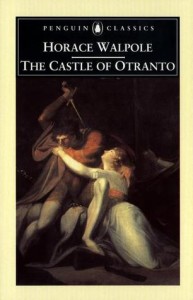Walpole, Horace (1769/2010). The Castle of Otranto. New York: Oxford World Classics.
This short book (115 pages), published in 1769, defined the Gothic novel form. It is full of murky castles, stormy weather, princes in disguise, swooning maidens, unbelievable coincidences.
It is a very bad novel by modern literary standards. The characters are stereotypes, the language is contrived and stilted, punctuation is lacking, and the third-person narrator’s shifting of point of view (“head-hopping”) makes it hard to follow who is speaking, in some places. The story is so disjointed, it is unintentionally funny at times, tending to a Monty Python sketch. These literary flaws, by modern standards, highlight just how formal and proscriptive the modern literary form is. In its time, the novel was immensely popular, and I’m sure nobody thought it was badly written. The standards have changed.
Despite its literary badness, the novel is imaginative. For example, in an early scene, a huge armored helmet the size of a room appears out of nowhere and crushes the Prince’s son to death. This event is never explained. The disjointed surrealism is bizarre. This strange style raises a question: Why are so many modern novels realistically representational? Even sci-fi is expected to be plausible. What has become of the completely wild imagination creative writers are capable of? Readers apparently demand realism, or at least, so-called “magical realism.” I wonder why the modern novel is so tame?
Walpole probably read David Hume (whose main work was published in 1740). In the first half, Walpole seems to be writing metaphorically about philosophy of mind. The giant helmet is reason (the head) and just beneath the thin floor on which the helmet lands is a labyrinth of murky underground passages (the emotions, sentiments; the unconscious 150 years before Freud?) Another strong theme is political: the arbitrary and capricious power of the state is represented by the Prince of Otranto. So despite its surface silliness, the novel does manage to present important thematic material in metaphor.
You wouldn’t read this novel today because it is a “good read.” You’d read it to get an understanding of how much the novel form in English has changed, and to get a sense of how the “gothic” genre got its start.

